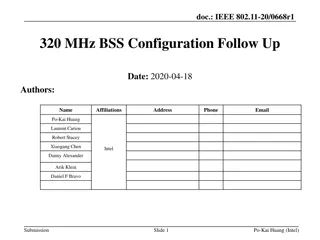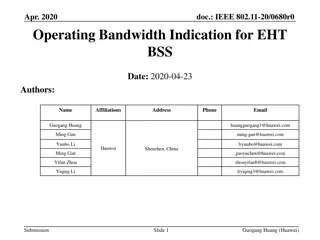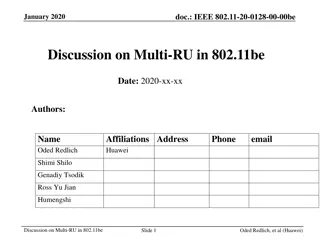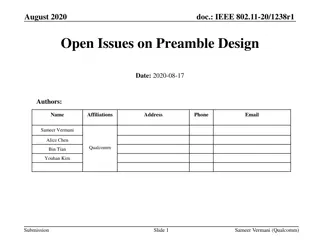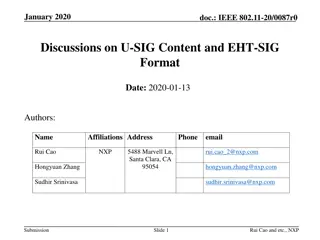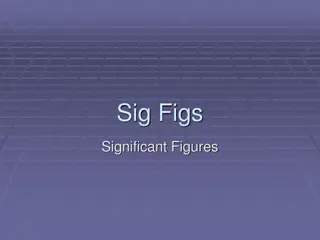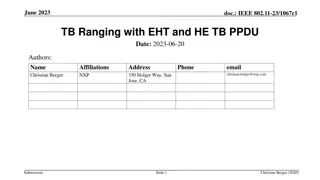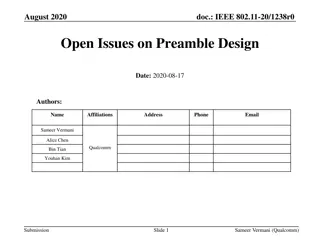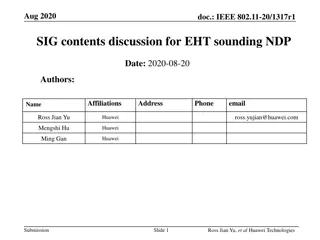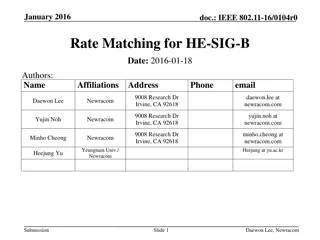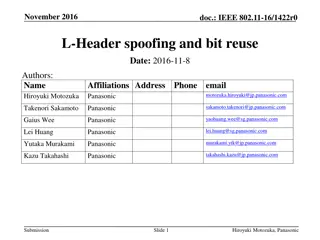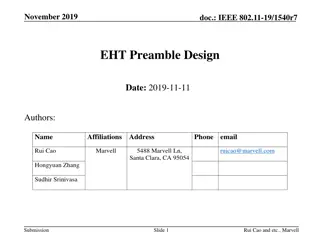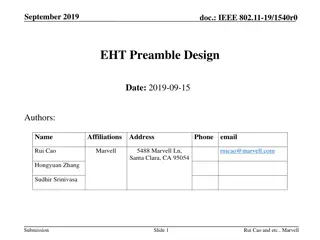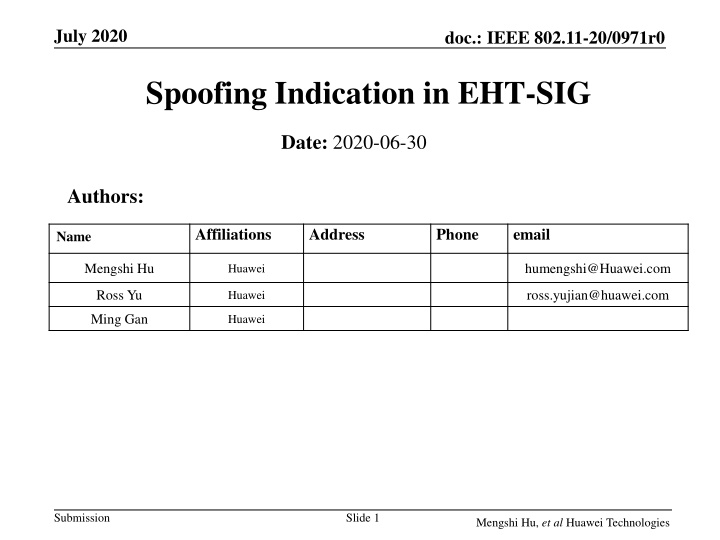
IEEE 802.11-20/0971r0 EHT-SIG Spoofing Indication
Explore the proposal for spoofing indication in EHT-SIG within the IEEE 802.11-20/0971r0 documentation, discussing EHT PPDU formats, per-80MHz preamble signaling, number of RU allocation subfields, and spoofing signaling in per-80MHz. Understand the efficient use of signaling in various resource granularities to optimize network overhead.
Download Presentation

Please find below an Image/Link to download the presentation.
The content on the website is provided AS IS for your information and personal use only. It may not be sold, licensed, or shared on other websites without obtaining consent from the author. If you encounter any issues during the download, it is possible that the publisher has removed the file from their server.
You are allowed to download the files provided on this website for personal or commercial use, subject to the condition that they are used lawfully. All files are the property of their respective owners.
The content on the website is provided AS IS for your information and personal use only. It may not be sold, licensed, or shared on other websites without obtaining consent from the author.
E N D
Presentation Transcript
July 2020 doc.: IEEE 802.11-20/0971r0 Spoofing Indication in EHT-SIG Date: 2020-06-30 Authors: Affiliations Address Phone email Name Mengshi Hu humengshi@Huawei.com Huawei Ross Yu ross.yujian@huawei.com Huawei Ming Gan Huawei Submission Slide 1 Mengshi Hu, et al Huawei Technologies
July 2020 doc.: IEEE 802.11-20/0971r0 EHT PPDU Format EHT has adopted the following format of an EHT PPDU sent to multiple users [1]. There shall be a 2 OFDM symbol long, jointly encoded U-SIG in the EHT preamble immediately after the RL-SIG. The EHT-SIG (immediately after the U-SIG) in an EHT PPDU sent to multiple users shall have a common field and user-specific field(s). Special case compressed modes (e.g., full BW MU-MIMO) are TBD. An RU Allocation subfield is present in the Common field of the EHT-SIG field of an EHT PPDU sent to multiple users. Compressed modes are TBD. Contents of the RU Allocation subfield are TBD. L-STF L-LTF L-SIG RL-SIG U-SIG EHT-SIG EHT-STF EHT-LTF Data Common field User Specific field RU Allocation subfield Submission Slide 2 Mengshi Hu, et al Huawei Technologies
July 2020 doc.: IEEE 802.11-20/0971r0 Per-80MHz Preamble Signaling On the basis of the EHT PPDU format sent to multiple users, an efficient per-80MHz preamble structure is designed [2-4]. Information in U-SIG is allowed to vary from one 80 MHz to the next in an EHT PPDU of bandwidth > 80MHz Within each 80MHz, U-SIG is still duplicated in every non-punctured 20MHz. EHT-SIG may carry different content in each 80MHz. A STA only needs to process up to one 80 MHz segment of the pre-EHT preamble (up-to and including EHT-SIG) to get all the assignment information for itself. U-SIG2 EHT-SIG2_2 U-SIG2 EHT-SIG2_1 Secondary 80MHz U-SIG2 EHT-SIG2_2 In the per-80MHz preamble structure, a STA parked on the secondary 80MHz only needs to process its corresponding 80MHz segment of the pre-EHT preamble (up-to and including EHT-SIG) to get all the assignment information for itself. U-SIG2 EHT-SIG2_1 U-SIG1 EHT-SIG1_2 U-SIG1 EHT-SIG1_1 Primary 80MHz U-SIG1 EHT-SIG1_2 U-SIG1 EHT-SIG1_1 Submission Slide 3 Mengshi Hu, et al Huawei Technologies
July 2020 doc.: IEEE 802.11-20/0971r0 Number of RU Allocation Subfields In [5], we have discussed the non-compressed OFDMA mode (11be baseline method, similar as 11ax): RU Allocation subfield in the common field indicates the RU assignment information with granularity of 20MHz N RU Allocation subfields in one CC, where N=1 for 20/40MHz, N=2 for 80MHz, N=4 for 160MHz, and N=8 for 320MHz needed for non-SST scenarios The baseline method enables allocating the RU/MRU in other segments to a STA (cross-segment allocation). Submission Slide 4 Mengshi Hu, et al Huawei Technologies
July 2020 doc.: IEEE 802.11-20/0971r0 Spoofing Signaling in Per-80MHz On the basis of the above baseline configuration, here we propose a spoofing signaling to save the overhead of User Specific fields. Here we classify the spoofing signaling into three types from the perspectives of different resource granularities. Spoofing signaling in small-RU granularity Spoofing signaling in large-RU granularity Spoofing signaling in segment granularity In the following, we give the details of the proposed methods. Submission Slide 5 Mengshi Hu, et al Huawei Technologies
July 2020 doc.: IEEE 802.11-20/0971r0 Spoofing Signaling in Small-RU Granularity Spoofing signaling in small-RU granularity indicates a spoofing design utilizing small RU. Small RU means the RU with size smaller than 242 tones. The main idea is to use a smaller number of small RUs to replace the practical assigned small RUs which are not allocated to the users parked on this segment. Example: 20MHz Practical Allocation Need 9 user fields ... 26 26 26 26 26 ... 26 26 26 26 Signaling for Segment 1 Need 5 user fields 52 26 106 ... ... 26 26 Signaling for Segment 2 Need 8 user fields 26 26 26 26 26 52 ... 26 26 ... 160MHz PPDU Yellow block: Practical RUs allocated to STAs in segment 1 Orange block: Practical RUs allocated to STAs in segment 2 White block: Dummy RUs through spoofing signaling Submission Slide 6 Mengshi Hu, et al Huawei Technologies
July 2020 doc.: IEEE 802.11-20/0971r0 Spoofing Signaling in Large-RU Granularity Spoofing signaling in large-RU granularity indicates a spoofing design utilizing large RU. Large RU means the RU with the size larger than or equal to 242 tones. The main idea is to use RU Allocation subfield corresponding to the large RU and zero user field to replace the practical assigned RUs which are not allocated to the users parked on this segment. Example: 160MHz The user fields corresponding to 9 26-tone RUs can be saved in Segment 1 Practical Allocation 9 26-tone RU 484 484 242 484 Signaling for Segment 1 484 242 484 484 242 (0) The user fields corresponding to these yellow blocks can be saved in Segment 2 Signaling for Segment 2 9 26-tone RU 996 (0) 242 (0) 484 (0) Segment 1 Segment 2 Yellow block: Practical RUs allocated to STAs in segment 1 Orange block: Practical RUs allocated to STAs in segment 2 White block: Dummy RUs through spoofing signaling Note that 484 (0) and 996 (0) can also be replaced by multiple 242 (0). Submission Slide 7 Mengshi Hu, et al Huawei Technologies
July 2020 doc.: IEEE 802.11-20/0971r0 Spoofing Signaling in Segment Granularity Spoofing signaling in segment granularity indicates a spoofing design utilizing non-OFDMA signaling in a segment The segment granularity indicates the resources allocated to a segment can be regarded as a non-OFDMA mode [6]. This spoofing signaling can be used when the resource allocated to one segment is non-OFDMA and can be indicated by preamble puncture information. Thus the RU Allocation subfield can also be saved. Example: 160MHz Practical Allocation 996+484 996+484 996+484 484 Signaling for Segment 1 This can be signaled by a non- OFDMA compression mode 996+484 996+484 996+484 Signaling for Segment 2 484 996 (0) 242 (0) 242 (0) Segment 1 Segment 2 Yellow block: Practical RUs allocated to STAs in segment 1 Orange block: Practical RUs allocated to STAs in segment 2 White block: Dummy RUs through spoofing signaling Grey block: Dummy punctured RU Submission Slide 8 Mengshi Hu, et al Huawei Technologies
July 2020 doc.: IEEE 802.11-20/0971r0 Overhead Analysis of Spoofing Signaling Granularity Description OVERHEAD SAVED Small RU 1. The User fields related to the users parked on the other segments can be saved, but some other user fields may be needed to be aligned with an available allocation entry in RU Allocation subfield. 1. Up to 6 user fields per 242-tone boundary* (It depends available pattern in RU Allocation subfield) on allocation the Large RU 1. The User fields related to the users parked on the other segments can be saved. 1. Up to 9 user fields per 242-tone boundary Segment 1. 2. The RU Allocation subfield can be saved. The User fields related to the users parked on the other segments can be saved 1. The RU Allocation subfield can be saved 2. Up to 9 user fields per 242-tone boundary Note*: For example, 6 user fields can be saved by using [106 26 106] to replace [26 26 26 26 26 26 26 26 26]. The red color indicates the practical resource allocated to the user belonging to its corresponding segment In average, one user field consumes 27 bits (22 info bits + 5 bits half of CRC and tail), around 4 bytes per user Submission Slide 9 Mengshi Hu, et al Huawei Technologies
July 2020 doc.: IEEE 802.11-20/0971r0 Summary To save the overhead of EHT-SIG, the RU Allocation subfield may not need to reflect the practical allocation of the whole bandwidth.Each segment only needs to focus on the allocation of its own users (the users parked on it). Three types of spoofing signaling in per-80MHz is given from the perspectives of different resource granularities. Spoofing signaling in small-RU granularity Spoofing signaling in large-RU granularity Spoofing signaling in segment granularity Submission Slide 10 Mengshi Hu, et al Huawei Technologies
July 2020 doc.: IEEE 802.11-20/0971r0 References [1] IEEE 802.11-20/0566r34 Compendium of straw polls and potential changes to the Specification Framework Document [2] IEEE 802.11-20/0439r0 Efficient EHT Preamble Design [3] IEEE 802.11-20/0380r0 U-SIG Structure and Preamble Processing [4] IEEE 802.11-20/0605r0 Further Discussions on Efficient EHT Preamble [5] IEEE 802.11-20/0922r2 RU allocation subfield in EHT-SIG Follow up II [6] IEEE 802.11-20/0783r1 EHT-SIG Compression Format Submission Slide 11 Mengshi Hu, et al Huawei Technologies
July 2020 doc.: IEEE 802.11-20/0971r0 Straw Poll #1 Do you agree that the RU Allocation subfields in different segments corresponding to a same 20MHz can be different? The RU Allocation subfields in each segment only need to reflect the practical allocation of the users parked on that segment The RU Allocation subfields may not need to reflect the practical allocation of the whole bandwidth Submission Slide 12 Mengshi Hu, et al Huawei Technologies

